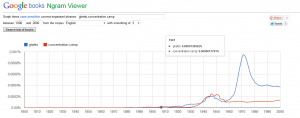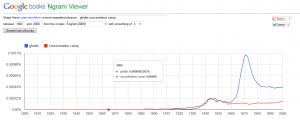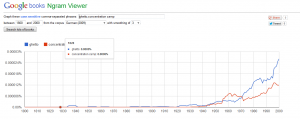I enjoyed doing some random word searches with Google Ngram over the weekend; for today’s post, I decided to focus on two terms related to the research I’ve been doing for another history class about the Holocaust. I chose “ghetto” and “concentration camp” and performed this search using four corpora: English, English (2009), German, and German (2009). I also tried to perform the search in Hebrew, but it yielded no results, which I thought was very curious.
As Joyce mentioned in her post, seeing trends in word usage as presented by Ngram is neat, but it doesn’t provide the opportunity to completely evaluate such trends because the books from which the data is drawn are not listed and other sources–like periodicals and journals–are not incorporated. A little confusion also exists because of the discrepancies in search results between similar categories (for example, German and German (2009).) While both corpora span the same number of years, they yield strikingly different results that are not immediately explainable. Despite these hesitations, Ngram Viewer seems a great tool for gaining general knowledge of word patterns as a basis for further research.
English:
The graphs resulting from searching “English” and “English (2009)” were very similar; both seemed to present the same general data: use of the term “ghetto” peaked during the mid-1970s, and the use of “concentration camp” spiked during the mid-1940s through the 1950s. These trends seem to be reasonable at face value, though they also call for further research. Concentration camps were liberated by the Allies in the mid-1940s, so it seems logical that a large number of volumes would be produced in the years following the end of the war, as soldiers recounted their stories and official government statements and photographs were released to the public. Perhaps the upswing in the usage of the term “ghetto” during the early 1970s can be explained by the fact that it took many Holocaust survivors decades to talk about their experiences, and that some of the earlier testimonies were not published in English for many years (both of these scenarios have played out in the research I have been doing about the Warsaw Ghetto Uprising).
English (2009):
German:
It is more difficult to explain the trends of the words’ usage in German, especially because the corpora yielded very different results. The German corpora showed the use of “concentration camp” peaking during the late-1940s and early-1950s with a resurgence in the late-1990s, while the German (2009) corpora showed a much smaller concentration of the word (the line was less steep) and peaked around the early- to mid-1960s (though it does also show a resurgence during the late-1990s). The German corpora shows the use of “ghetto” as increasing dramatically from the Holocaust to the present and peaking where the chart’s data ends, at the year 2000. The German (2009) information is similar, with its peak around the year 2000, but it has a less steep a slope than the original corpora. I’m not entirely sure how to interpret this data.
German (2009):





When I initially chose “ghetto” as one of the words to use in the Ngram, I considered the fact that it might include references to African American “ghettos”. This point was brought up in class, and I realized to a greater extent how much it probably influenced the results, especially because the search was conducted in English. If I choose to use an Ngram comparison in my final project, this is something I’ll really have to keep in mind.